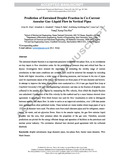JavaScript is disabled for your browser. Some features of this site may not work without it.
| dc.contributor.author | Aliyu, A. M. | |
| dc.contributor.author | Almabrok, Almabrok Abushanaf | |
| dc.contributor.author | Baba, Yahaya D. | |
| dc.contributor.author | Archibong-Eso, Archibong | |
| dc.contributor.author | Lao, Liyun | |
| dc.contributor.author | Yeung, Hoi | |
| dc.contributor.author | Kim, K. C. | |
| dc.date.accessioned | 2017-03-24T11:30:23Z | |
| dc.date.available | 2017-03-24T11:30:23Z | |
| dc.date.issued | 2017-03-07 | |
| dc.identifier.citation | Aliyu AM, Almabrok AA, et al., (2017) Prediction of entrained droplet fraction in co-current annular gas–liquid flow in vertical pipes. Experimental Thermal and Fluid Science, Volume 85, July 2017, pp. 287-304 | en_UK |
| dc.identifier.issn | 0894-1777 | |
| dc.identifier.uri | http://dx.doi.org/10.1016/j.expthermflusci.2017.03.012 | |
| dc.identifier.uri | https://dspace.lib.cranfield.ac.uk/handle/1826/11650 | |
| dc.description.abstract | The entrained droplet fraction is an important parameter in annular two-phase flow, as its correlations are key inputs in flow simulation codes for the prediction of pressure drop and critical heat flux or dryout. Investigators have stressed the importance of extending the validity range of current correlations so that more conditions are covered. This could be achieved for example by including fluids with higher viscosities, a wider range of operating pressures, and increase in the size of pipes used for experiments (most of the data in the literature are from pipes of 50 mm diameter and below). In attempt to improve the latter, experiments were conducted in a 101.6 mm gas–liquid flow loop at Cranfield University’s Oil and Gas Engineering Laboratory and data on the fraction of droplets were collected in the annular flow regime by measuring the film velocity, from which the droplet fraction was calculated. Comparison of the film velocity by this method and by a mass balance showed close agreement. A capacitance Wire Mesh Sensor was used for flow visualisation in order to distinguish between annular and churn flow. In order to arrive at an improved correlation, over 1300 data points were gathered from other published works. These include air–water studies where large pipes of up to 127 mm in diameter were used. The others were from small-diameter pipes and for refrigerant, steam–water, air–water, and air–glycerine flows. Since in the annular regime, the gas flow entrains liquid droplets into the core, their presence alters the properties of the gas core. Therefore, accurate predictions are pivotal for the energy efficient design and operation of facilities in the petroleum and nuclear power industry. The correlation obtained here showed good agreement with the collected databank. | en_UK |
| dc.language.iso | en | en_UK |
| dc.publisher | Elsevier | en_UK |
| dc.rights | Attribution-NonCommercial-NoDerivatives 4.0 International | |
| dc.rights.uri | http://creativecommons.org/licenses/by-nc-nd/4.0/ | |
| dc.subject | Droplet entrainment | en_UK |
| dc.subject | Large diameter pipes | en_UK |
| dc.subject | Two-phase flow | en_UK |
| dc.subject | Sauter mean diameter | en_UK |
| dc.subject | Wire Mesh Sensor | en_UK |
| dc.title | Prediction of entrained droplet fraction in co-current annular gas–liquid flow in vertical pipes | en_UK |
| dc.type | Article | en_UK |
Files in this item
This item appears in the following Collection(s)
-
Staff publications (SATM) [4365]

